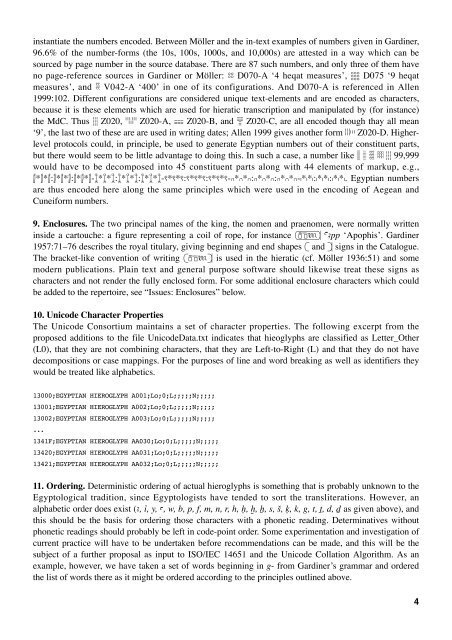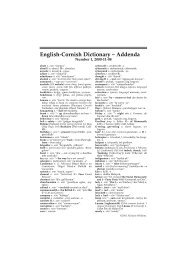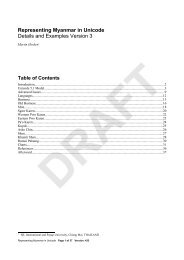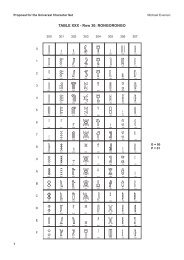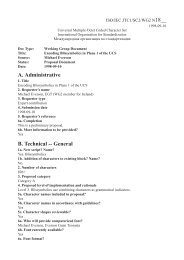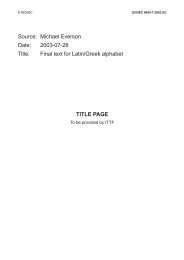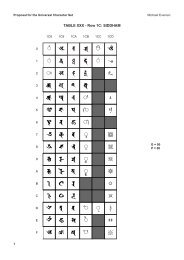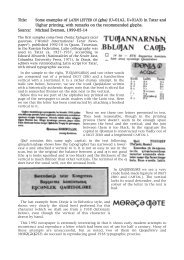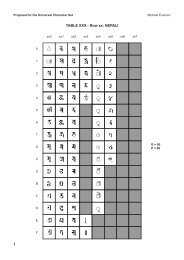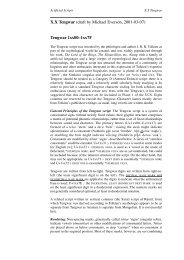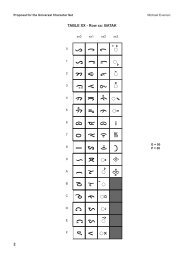Towards a Proposal to encode Egyptian Hieroglyphs in ... - Evertype
Towards a Proposal to encode Egyptian Hieroglyphs in ... - Evertype
Towards a Proposal to encode Egyptian Hieroglyphs in ... - Evertype
Create successful ePaper yourself
Turn your PDF publications into a flip-book with our unique Google optimized e-Paper software.
<strong>in</strong>stantiate the numbers <strong>encode</strong>d. Between Möller and the <strong>in</strong>-text examples of numbers given <strong>in</strong> Gard<strong>in</strong>er,<br />
96.6% of the number-forms (the 10s, 100s, 1000s, and 10,000s) are attested <strong>in</strong> a way which can be<br />
sourced by page number <strong>in</strong> the source database. There are 87 such numbers, and only three of them have<br />
no page-reference sources <strong>in</strong> Gard<strong>in</strong>er or Möller: „ D070-A ‘4 heqat measures’, ‰ D075 ‘9 heqat<br />
measures’, and  V042-A ‘400’ <strong>in</strong> one of its configurations. And D070-A is referenced <strong>in</strong> Allen<br />
1999:102. Different configurations are considered unique text-elements and are <strong>encode</strong>d as characters,<br />
because it is these elements which are used for hieratic transcription and manipulated by (for <strong>in</strong>stance)<br />
the MdC. Thus Ê Z020, ä Z020-A, ã Z020-B, and å Z020-C, are all <strong>encode</strong>d though thay all mean<br />
‘9’, the last two of these are are used <strong>in</strong> writ<strong>in</strong>g dates; Allen 1999 gives another form ç Z020-D. Higherlevel<br />
pro<strong>to</strong>cols could, <strong>in</strong> pr<strong>in</strong>ciple, be used <strong>to</strong> generate <strong>Egyptian</strong> numbers out of their constituent parts,<br />
but there would seem <strong>to</strong> be little advantage <strong>to</strong> do<strong>in</strong>g this. In such a case, a number like ÿŸ⁄€‹99,999<br />
would have <strong>to</strong> be decomposed <strong>in</strong><strong>to</strong> 45 constituent parts along with 44 elements of markup, e.g.,<br />
›*›*›:›*›*›:›*›*›-fi*fi*fi:fi*fi*fi:fi*fi*fi-fl*fl*fl:fl*fl*fl:fl*fl*fl-‡*‡*‡:‡*‡*‡:‡*‡*‡-·*·*·:·*·*·:·*·*·. <strong>Egyptian</strong> numbers<br />
are thus <strong>encode</strong>d here along the same pr<strong>in</strong>ciples which were used <strong>in</strong> the encod<strong>in</strong>g of Aegean and<br />
Cuneiform numbers.<br />
9. Enclosures. The two pr<strong>in</strong>cipal names of the k<strong>in</strong>g, the nomen and praenomen, were normally written<br />
<strong>in</strong>side a car<strong>to</strong>uche: a figure represent<strong>in</strong>g a coil of rope, for <strong>in</strong>stance “ ≠¨pp ‘Apophis’. Gard<strong>in</strong>er<br />
1957:71–76 describes the royal titulary, giv<strong>in</strong>g beg<strong>in</strong>n<strong>in</strong>g and end shapes œ and — signs <strong>in</strong> the Catalogue.<br />
The bracket-like convention of writ<strong>in</strong>g œ–— is used <strong>in</strong> the hieratic (cf. Möller 1936:51) and some<br />
modern publications. Pla<strong>in</strong> text and general purpose software should likewise treat these signs as<br />
characters and not render the fully enclosed form. For some additional enclosure characters which could<br />
be added <strong>to</strong> the reper<strong>to</strong>ire, see “Issues: Enclosures” below.<br />
10. Unicode Character Properties<br />
The Unicode Consortium ma<strong>in</strong>ta<strong>in</strong>s a set of character properties. The follow<strong>in</strong>g excerpt from the<br />
proposed additions <strong>to</strong> the file UnicodeData.txt <strong>in</strong>dicates that hieoglyphs are classified as Letter_Other<br />
(L0), that they are not comb<strong>in</strong><strong>in</strong>g characters, that they are Left-<strong>to</strong>-Right (L) and that they do not have<br />
decompositions or case mapp<strong>in</strong>gs. For the purposes of l<strong>in</strong>e and word break<strong>in</strong>g as well as identifiers they<br />
would be treated like alphabetics.<br />
13000;EGYPTIAN HIEROGLYPH A001;Lo;0;L;;;;;N;;;;;<br />
13001;EGYPTIAN HIEROGLYPH A002;Lo;0;L;;;;;N;;;;;<br />
13002;EGYPTIAN HIEROGLYPH A003;Lo;0;L;;;;;N;;;;;<br />
...<br />
1341F;EGYPTIAN HIEROGLYPH AA030;Lo;0;L;;;;;N;;;;;<br />
13420;EGYPTIAN HIEROGLYPH AA031;Lo;0;L;;;;;N;;;;;<br />
13421;EGYPTIAN HIEROGLYPH AA032;Lo;0;L;;;;;N;;;;;<br />
11. Order<strong>in</strong>g. Determ<strong>in</strong>istic order<strong>in</strong>g of actual hieroglyphs is someth<strong>in</strong>g that is probably unknown <strong>to</strong> the<br />
Egyp<strong>to</strong>logical tradition, s<strong>in</strong>ce Egyp<strong>to</strong>logists have tended <strong>to</strong> sort the transliterations. However, an<br />
alphabetic order does exist (¨, ñ, y, Æ, w, b, p, f, m, n, r, h, h. , h, h, s, sˇ, k. , k, g, t, t,<br />
d, d as given above), and<br />
˘ ¯ ¯ ¯<br />
this should be the basis for order<strong>in</strong>g those characters with a phonetic read<strong>in</strong>g. Determ<strong>in</strong>atives without<br />
phonetic read<strong>in</strong>gs should probably be left <strong>in</strong> code-po<strong>in</strong>t order. Some experimentation and <strong>in</strong>vestigation of<br />
current practice will have <strong>to</strong> be undertaken before recommendations can be made, and this will be the<br />
subject of a further proposal as <strong>in</strong>put <strong>to</strong> ISO/IEC 14651 and the Unicode Collation Algorithm. As an<br />
example, however, we have taken a set of words beg<strong>in</strong>n<strong>in</strong>g <strong>in</strong> g- from Gard<strong>in</strong>er’s grammar and ordered<br />
the list of words there as it might be ordered accord<strong>in</strong>g <strong>to</strong> the pr<strong>in</strong>ciples outl<strong>in</strong>ed above.<br />
4


